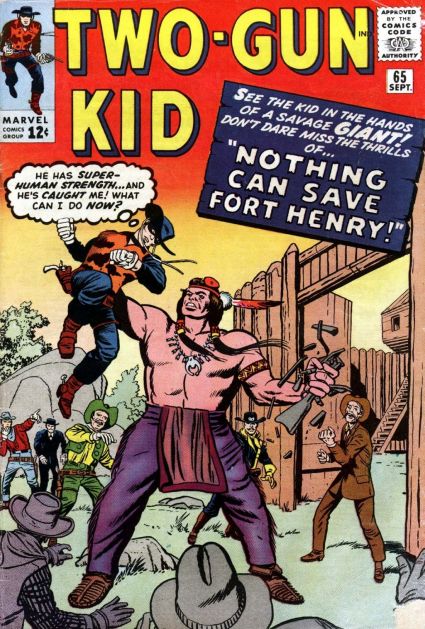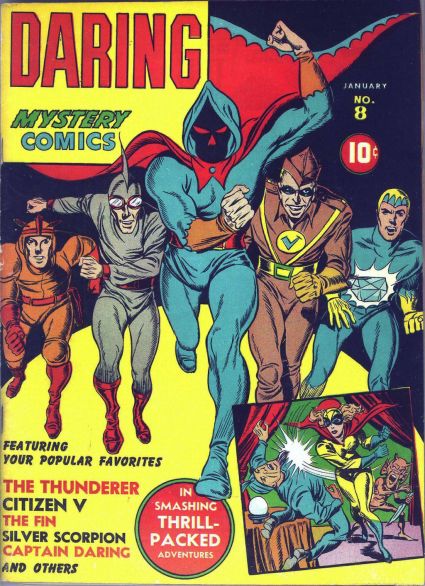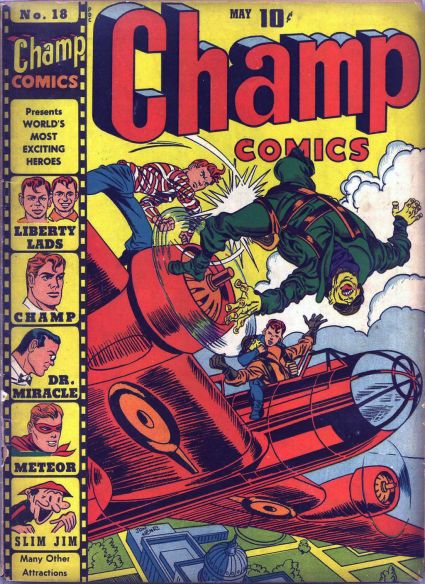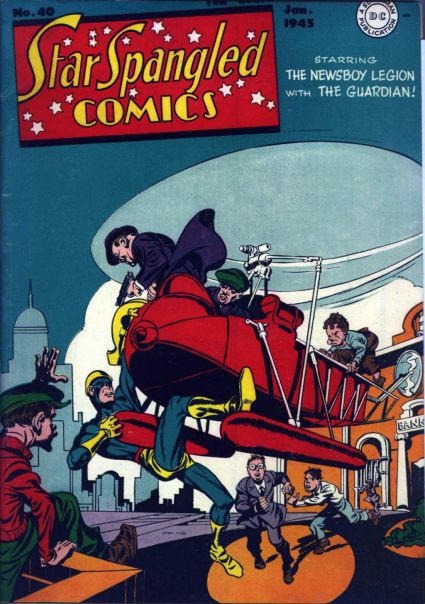Kirby’s only cover for the short lived super-team, it’s always nice to see another one of those overhead cityscapes by Kirby, as well as a nice drawing of Hercules, plus a very 1970s villain. Inked by Frank Giacoia.

Published 1976


Kirby’s only cover for the short lived super-team, it’s always nice to see another one of those overhead cityscapes by Kirby, as well as a nice drawing of Hercules, plus a very 1970s villain. Inked by Frank Giacoia.

Published 1976
This is one of my favourite TWO-GUN KID covers, with a nice feeling of power and menace in the villain and some nice detail over in the fort. Dick Ayers inks this one.

Published 1963
In “The Fall of Asgard”, Thor is on Earth, tending to business like rounding up hijackers, while the Warriors Three and Balder are leaving the realm of the Norn Queen. Odin picks this time to go into the Odinsleep that he needs to retain his Odinpowers for another Odincycle, leaving the Odinrealm open for attack by the evil Odinson Loki, who gathers various Odinfoes like the storm giants.
The page after this, a full page of the giants on the rampage, is gorgeous, by the way. Check it out if you have this issue.
Sif is able to contact Thor on Earth and get him to return to Asgard, and he and the various defenders of the realm battle the invaders, but not before Loki is able to get the Ring Imperial from the Allfather and take Sif prisoner, making him Thor and the other bow before him.
Bill Everett inks the 20-page story, the last of his brief run (with some possible assistance from John Verpoorten, see comments). It’s kind of uneven compared to his others, although still better than most Thor inking. Some pages are great, but a few others seems stiff, maybe a bit rushed.
The cover is by Marie Severin, replacing the one Kirby did. The likely reason for the replacement is the the Kirby version (shown in TJKC #18) has Thor bowing before Loki, defeated, while the published version has him still defiant, so I guess someone decided the hero should look more heroic on the cover. Both versions do seem to use the same background of Asgard, though, and Severin does do a good Kirby (in fact, the original art boards to both versions shown in TJKC are signed by Kirby).
Published 1970
A year after the previous series, Kirby returns to the toy line inspired SUPER POWERS, which I think by this time was also part of the Super Friends cartoon, which I guess explains the Hall of Justice super-hero HQ in this issue. Anyway, Kirby doesn’t write this series, just pencils. We open just after the events of “The Hunger Dogs”, with Darkseid’s rule overturned.
He’s able to find some of his most loyal servants, DeSaad, Kalibak and Steppenwolf (actually just “animated bodies” of them that he brought back to life) and escape to the moon, where they plan the conquest of Earth, which is where our various action figures, um, I mean, heroes, come in, splitting into teams to investigate five mysterious seeds which have appeared through the world, which seem to be digging to the Earth’s core. J’onn J’onzz goes to England where he meets up with Aquaman to investigate one of the seeds. While there, they encounter DeSaad, and all of them are hurled back in time where they meet King Arthur.
Kind of a dull story, although the art does have a few points of interest, mostly a few of the scenes with Darkseid in the first half.
Greg Theakston inks the cover and 23-page story.
Published 1985
The issue opens with OMAC enjoying some virtual reality entertainment, battling a monster protecting the secrets of the giant talking skulls. He’s pulled out of the “movie” to get his official credentials to act as a One Man Army on behalf of the faceless Global Peace Agents, but before he goes on his first official mission he’s introduced to a couple applying to act as his parents, OMAC having forgotten his life as Buddy Blank. I’m always unclear on how creepy Kirby meant this stuff to be.
OMAC is then sent on his mission to take down Marshal Kafka, a tyrant who has put together his own army of a hundred thousand. His jet is shot at on the way down, leaving him fighting from his chair until that’s shot out from under him. He quickly gets through the Kafka’s forces until he finally reaches the Marshal.
Like I said, a bit of a creepy beginning, followed by a quick high-action story. Kirby was throwing out the ideas fast in this series, a lot of which are never returned to.
D. Bruce Berry inks the cover and 20-page story.
Published 1975
DARING MYSTERY COMICS #8, 1942. You gotta feel for Blue Diamond. Right there on the cover, but grouped in with “and others” in the blurb, which names the other guys, and even the gal in the inset. I guess he did get his revenge by having more of a career when brought back in the 1970s than the others.

Anyway, a book of the also-rans of the early Marvel line, the highlight of most of these guys careers has to be having Jack Kirby draw them on a cover just before he left Marvel the first time.
CHAMP COMICS #18, 1942. Another wartime cover for Harvey, this one signed with the “Jon Henri” pen-name. Don’t try to think too much about how exactly the Liberty Lads got the jump on those Japanese pilots in mid-flight, much less how the Japanese pilots could attack Washington DC.

(note this is often listed with a 1941 date. Thanks to Harry at the S&K Blog for the correction)
This issue has an edited reprint of “The Sleeper Strikes” from CAPTAIN AMERICA #102 [1968]. One change made is right on the splash page, where a reference to the Lovin’ Spoonful is changed to Blue Oyster Cult. How hip. Anyway, Cap still has the control key for the Fourth Sleeper from last issue, but doesn’t know how to use it. He battles with the Red Skull’s agents, and is rescued by Agent 13, and they go out in pursuit of the Sleeper. Lots of good fighting throughout, although the end is a bit abrupt. One of the two pages edited is just a splash of the destruction when the Sleeper attacks, but another is kind of crucial to the climax of the story, so was a pretty bad cut.
Syd Shores inks the cover and edited-to-18-page story. There’s also some of the usual meddling on the cover, moving figures slightly. I’m still not a huge fan of Shores’ inks on Kirby during this time, and the linework of his that got lost the first time around suffers even more in the reprints.
Published 1977
Among Kirby’s work for Gilberton published in 1961, in addition to his one full issue of CLASSICS ILLUSTRATED, were a few short bits in five issues of THE WORLD AROUND US. This issue’s theme was Hunting, and Kirby contributed 12 pages, inked by Dick Ayers.
The Kirby starts on the title page, an image of some hunters getting ready to take down a bear with spears and arrows. The archer’s pose in the foreground is especially nice.
Later in the issue is the 6-page “Early Hunters” chapter, which has a quick summary of a few thousand years of mankind, starting with hunting with clubs and wandering from place to place as hunter/gatherers, and then developing more complex weapons and hunting techniques. Then follows the discovery of farming, allowing for permanent villages, and domesticating animals.
Following some non-Kirby stuff is the 5-page “An End to Slaughter”, which starts with the story of Theodore Roosevelt, starting with a quick look at his buffalo hunting as a youth, bear hunting as President and his post-presidency African safari. The story then goes to Roosevelt’s role in expanding the National Park system in the US and inspiring similar efforts around the world, and a look at protected lands in other countries and the importance of following hunting laws, getting proper licenses and all the rest.
This isn’t a bad sample of Kirby’s art, although clearly doing short vignettes, single panels on a theme, doesn’t really play to his story-telling strengths. There are also a few bits every now and then in the art that just feel off, which are likely panels or parts of panels that the Gilberton folks had redrawn, either by Kirby or by another artist to meet their standards of accuracy. A few of the animals seem to suffer from this on Kirby’s pages.
This issue also includes a lot of art by Sam Glanzman and a few pages by Pete Morisi, so is worth checking out for more than the Kirby.
Published 1961
STAR SPANGLED COMICS #40, 1945. Boy, is that a complicated flying machine for robbing a bank. If it actually works, you could sell the patent for more than a bank robbery would haul in, and not get beat up by a bunch of kids and a moonlighting cop.
